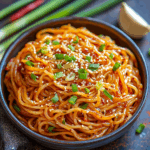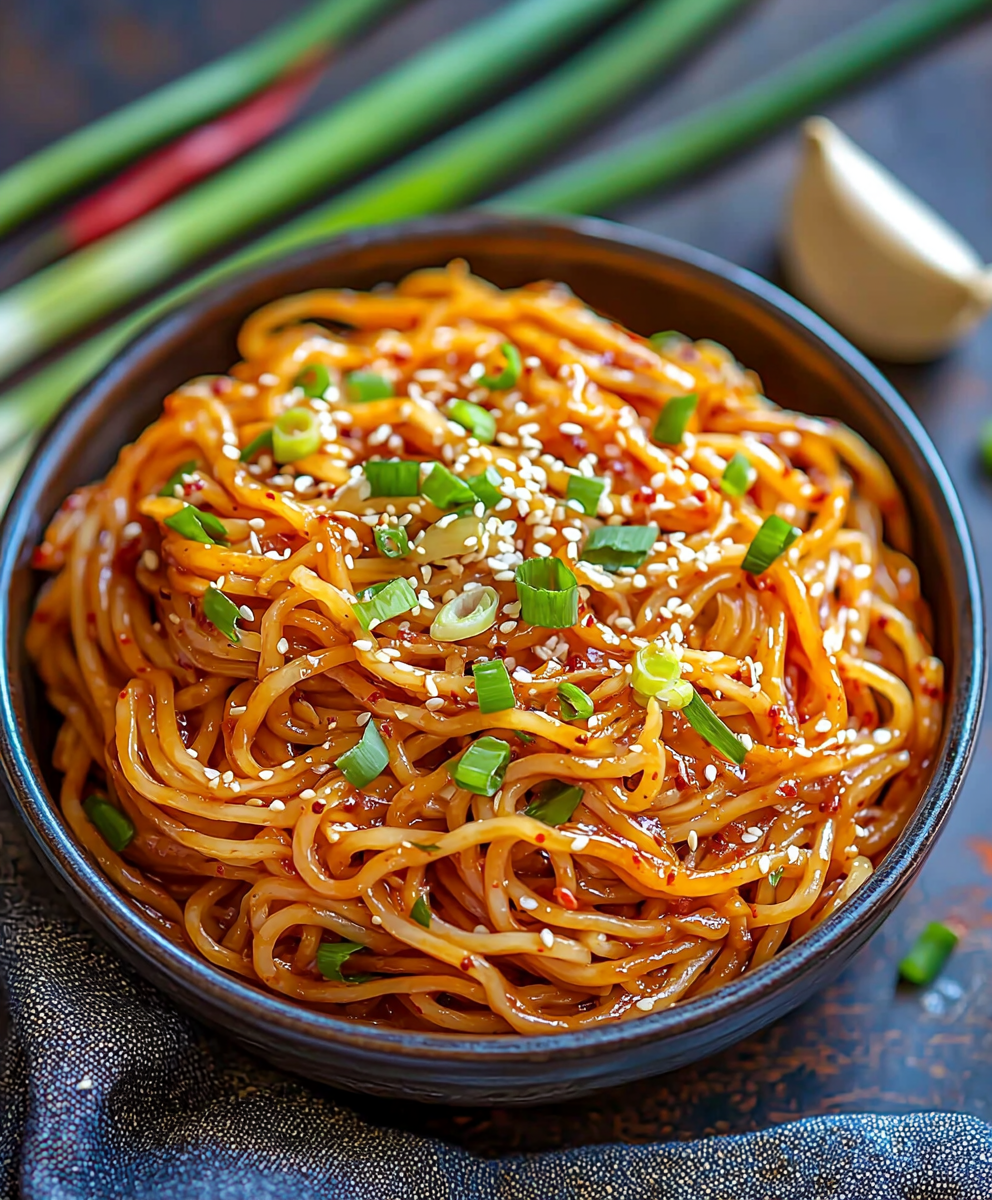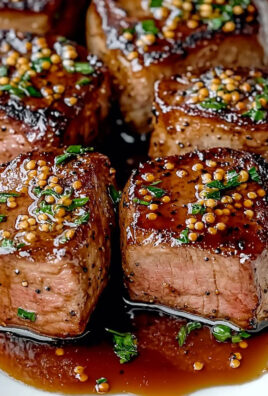Korean Gochujang Noodles are a delightful fusion of flavors that will transport your taste buds straight to the vibrant streets of Seoul. This dish, featuring the unique and spicy fermented chili paste known as gochujang, has become a beloved staple in Korean cuisine. The rich history of gochujang dates back centuries, where it was traditionally used to enhance the flavor of various dishes, making it a key ingredient in many Korean households.
What I love most about Korean Gochujang Noodles is their perfect balance of heat and umami, combined with a satisfying texture that keeps you coming back for more. The noodles are not only delicious but also incredibly convenient to prepare, making them an ideal choice for busy weeknights or a quick lunch. Whether you’re a fan of spicy food or just looking to try something new, these noodles are sure to become a favorite in your kitchen. Join me as we dive into this flavorful recipe that celebrates the essence of Korean cuisine!
Ingredients:
- 8 oz (225 g) of your favorite noodles (I love using udon or soba noodles)
- 2 tablespoons of gochujang (Korean red chili paste)
- 1 tablespoon of soy sauce
- 1 tablespoon of sesame oil
- 1 tablespoon of honey or maple syrup (for a vegan option)
- 2 cloves of garlic, minced
- 1 teaspoon of grated ginger
- 1 cup of mixed vegetables (like bell peppers, carrots, and broccoli)
- 1 tablespoon of vegetable oil (for stir-frying)
- 2 green onions, chopped (for garnish)
- Sesame seeds (for garnish)
- Optional: protein of your choice (tofu, chicken, or shrimp)
Preparing the Noodles
- Start by boiling a large pot of water. Once it’s at a rolling boil, add the noodles. Cook according to the package instructions until they are al dente. This usually takes about 5-7 minutes for udon or soba noodles.
- Once cooked, drain the noodles in a colander and rinse them under cold water to stop the cooking process. This also helps to remove excess starch, preventing them from sticking together.
- Set the noodles aside while you prepare the sauce and vegetables.
Making the Gochujang Sauce
- In a small bowl, combine the gochujang, soy sauce, sesame oil, honey (or maple syrup), minced garlic, and grated ginger. Mix well until you have a smooth sauce. Adjust the spice level by adding more gochujang if you like it spicier.
- Taste the sauce and adjust the sweetness or saltiness according to your preference. If you want a bit more heat, feel free to add a pinch of red pepper flakes.
Preparing the Vegetables
- While the noodles are cooking, wash and chop your mixed vegetables into bite-sized pieces. I usually go for a colorful mix of bell peppers, carrots, and broccoli, but feel free to use whatever you have on hand.
- If you’re adding protein, prepare it now. For tofu, cut it into cubes and pat it dry. For chicken or shrimp, make sure they are cleaned and cut into bite-sized pieces.
Cooking the Stir-Fry
- In a large skillet or wok, heat the vegetable oil over medium-high heat. Once the oil is hot, add the protein (if using) and cook until it’s browned and cooked through. This usually takes about 5-7 minutes for chicken or shrimp, and about 8-10 minutes for tofu. Remove the protein from the skillet and set it aside.
- In the same skillet, add the chopped vegetables. Stir-fry them for about 3-5 minutes until they are tender but still crisp. You want to maintain their vibrant colors and crunch.
- Once the vegetables are cooked, return the protein to the skillet (if using) and pour in the gochujang sauce. Stir everything together, ensuring the sauce coats the vegetables and protein evenly.
- Add the cooked noodles to the skillet. Toss everything together gently, making sure the noodles are well coated with the sauce. Cook for an additional 2-3 minutes, allowing the noodles to heat through and absorb the flavors of the sauce.
Assembling and Serving
- Once everything is well combined and heated through, remove the skillet from the heat. Taste the noodles and adjust the seasoning if necessary. You can add a splash more soy sauce or a drizzle of sesame oil if you like.
- To serve, plate the noodles in bowls. Garnish with chopped green onions and a sprinkle of sesame seeds for added texture and flavor.
- If you want to add a little extra flair, you can also top the noodles with a fried egg or some sliced avocado.
- Enjoy your delicious Korean gochujang noodles! They are perfect for a quick weeknight dinner or a cozy weekend meal.
Tips and Variations
Conclusion:
In summary, these Korean Gochujang Noodles are an absolute must-try for anyone looking to spice up their weeknight dinners or impress guests with a unique and flavorful dish. The combination of the rich, spicy gochujang sauce with the chewy noodles creates a delightful harmony that is both satisfying and addictive. Plus, the versatility of this recipe allows you to customize it to your liking—add in your favorite vegetables, protein, or even a sprinkle of sesame seeds for an extra crunch. I encourage you to give this recipe a go and experience the explosion of flavors for yourself. Whether you enjoy it as a standalone meal or pair it with some crispy Korean fried chicken or a refreshing cucumber salad, you won’t be disappointed. And don’t forget to share your experience! I would love to hear how your version of these Korean Gochujang Noodles turned out. So grab your ingredients, get cooking, and let the deliciousness unfold! Print
Korean Gochujang Noodles: A Spicy Delight for Your Taste Buds
- Total Time: 30 minutes
- Yield: 2 servings 1x
Description
Enjoy a quick and flavorful dish with these Korean Gochujang Noodles, featuring your choice of noodles stir-fried with fresh vegetables and a spicy-sweet gochujang sauce. Perfect for any night of the week!
Ingredients
- 8 oz (225 g) of your favorite noodles (udon or soba recommended)
- 2 tablespoons of gochujang (Korean red chili paste)
- 1 tablespoon of soy sauce
- 1 tablespoon of sesame oil
- 1 tablespoon of honey or maple syrup (for a vegan option)
- 2 cloves of garlic, minced
- 1 teaspoon of grated ginger
- 1 cup of mixed vegetables (bell peppers, carrots, broccoli)
- 1 tablespoon of vegetable oil (for stir-frying)
- 2 green onions, chopped (for garnish)
- Sesame seeds (for garnish)
- Optional: protein of your choice (tofu, chicken, or shrimp)
Instructions
- Start by boiling a large pot of water. Once it’s at a rolling boil, add the noodles. Cook according to the package instructions until they are al dente (about 5-7 minutes for udon or soba noodles).
- Once cooked, drain the noodles in a colander and rinse them under cold water to stop the cooking process and remove excess starch.
- Set the noodles aside while you prepare the sauce and vegetables.
- In a small bowl, combine the gochujang, soy sauce, sesame oil, honey (or maple syrup), minced garlic, and grated ginger. Mix well until you have a smooth sauce.
- Taste the sauce and adjust the sweetness or saltiness according to your preference. Add more gochujang for extra heat if desired.
- While the noodles are cooking, wash and chop your mixed vegetables into bite-sized pieces.
- If adding protein, prepare it now: cut tofu into cubes and pat dry, or clean and cut chicken or shrimp into bite-sized pieces.
- In a large skillet or wok, heat the vegetable oil over medium-high heat. Add the protein (if using) and cook until browned and cooked through (5-7 minutes for chicken or shrimp, 8-10 minutes for tofu). Remove from skillet and set aside.
- In the same skillet, add the chopped vegetables and stir-fry for 3-5 minutes until tender but still crisp.
- Return the protein to the skillet (if using) and pour in the gochujang sauce. Stir to coat everything evenly.
- Add the cooked noodles to the skillet and toss gently to combine, cooking for an additional 2-3 minutes to heat through.
- Remove the skillet from heat and taste the noodles, adjusting seasoning if necessary.
- Plate the noodles in bowls and garnish with chopped green onions and sesame seeds.
- Optional: top with a fried egg or sliced avocado for extra flair.
- Enjoy your delicious Korean gochujang noodles!
Notes
- Feel free to customize the vegetables based on what you have on hand.
- For a vegan option, use tofu and maple syrup.
- Adjust the spice level by varying the amount of gochujang used.
- Prep Time: 15 minutes
- Cook Time: 15 minutes






Leave a Comment